| Author |
Message |
Mihai Georgescu

|
 Posted: Mon 07 Mar, 2011 11:12 am Post subject: Hafting a Dane axe Posted: Mon 07 Mar, 2011 11:12 am Post subject: Hafting a Dane axe |
 |
|
Hi everybody!
I've just received my GDFB axe head and will (hopefully) start hafting it soon, and I will be documenting it along the way for future reference and general advice grabbing.
Here's the head as I received it this morning:
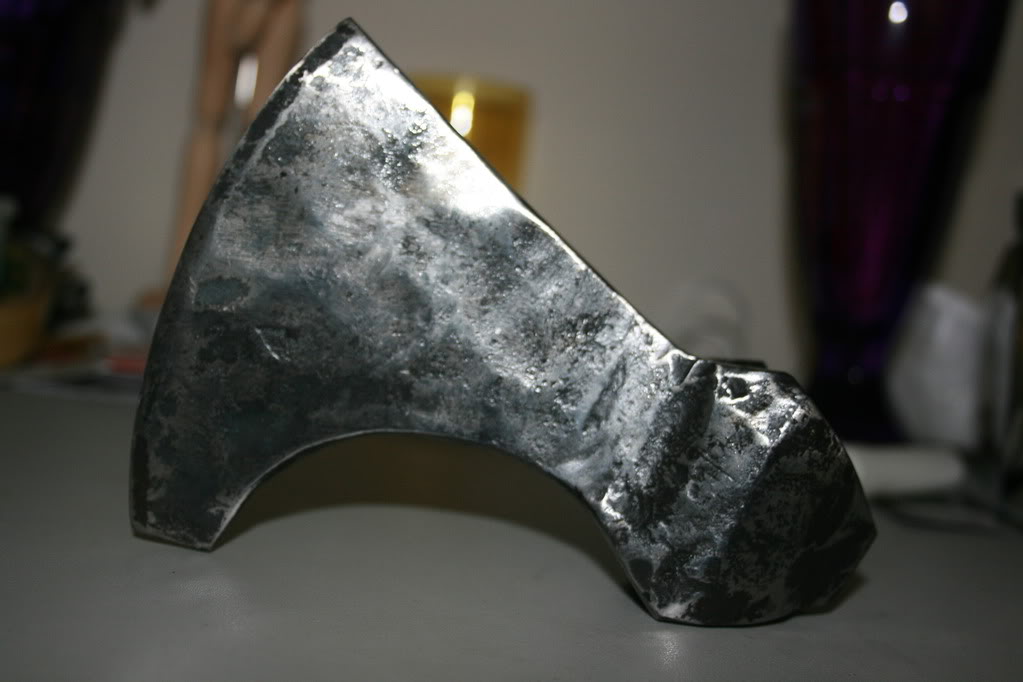
Might be getting it drilled for free (I certainly hope so)
I'm slightly worried about the haft. It's a freebie I got from work and I'm not too sure whether it's hardwood or not (or what wood it is, for that matter). At the moment it's a little manky, as it's been abandoned in an old storage and needs a good scrub with...gods know what (tried a tile cleaner, but it's still quite sticky). That aside, here's a couple of shots of it and the grain (I've been told it could be beech...is that suitable for a battle-ready haft?) :
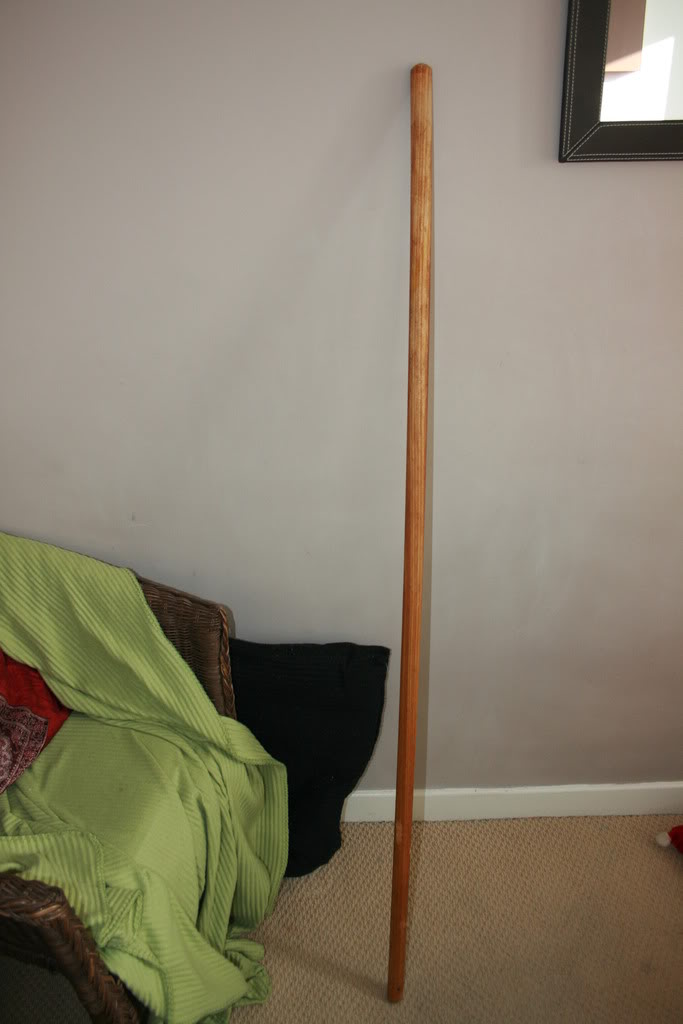
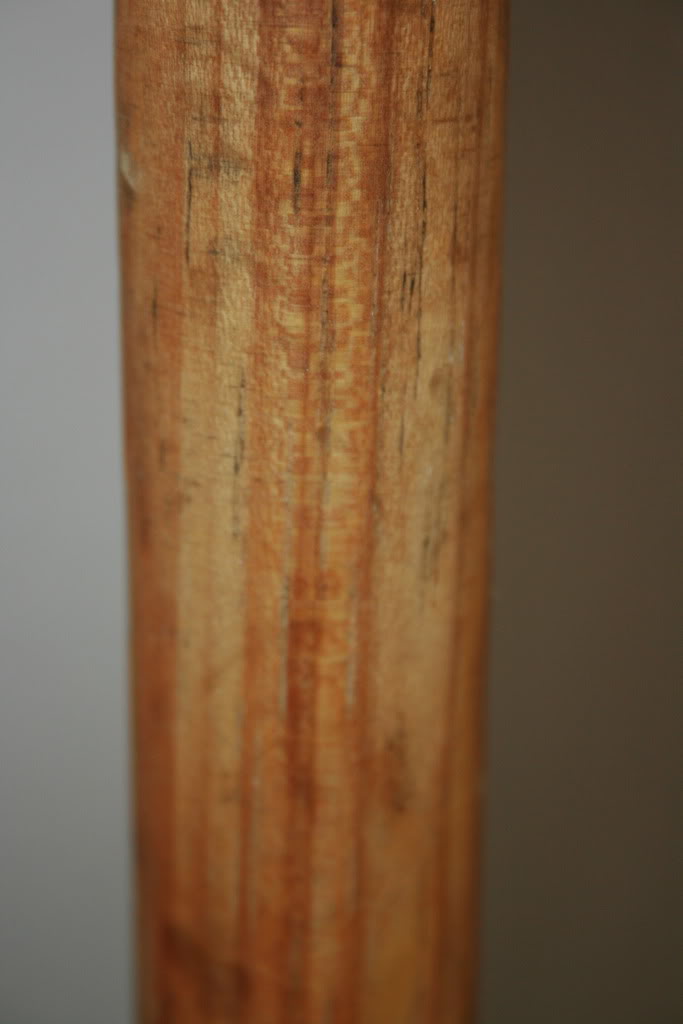
And a hefty notch in it from a long time ago. Not sure how hard the hit was to make that mark...
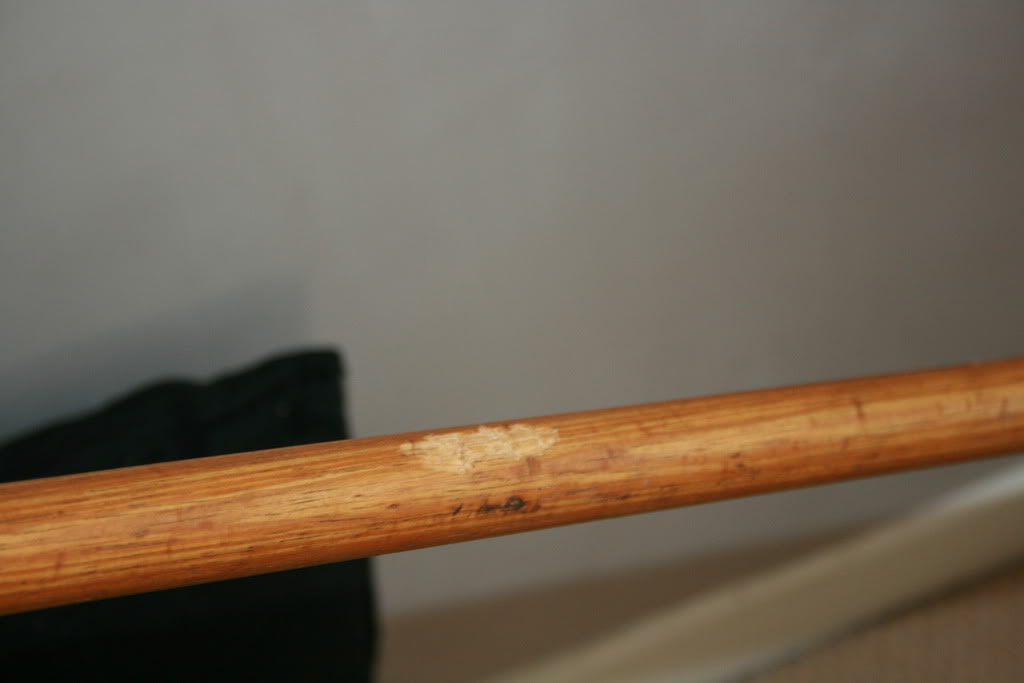
Later on, I want to add some banding to it (I think brass), like this axe here:
http://www.hurstwic.org/history/articles/manu...aft_cu.jpg
http://www.hurstwic.org/history/articles/manu...d_haft.jpg
Soon I will be trimming it down to size and carving the top for the axe head.
EDIT: one vote for beech and one for pine...Might as well start looking for a new one if it's pine...
|
|
  |
 |
Martin Erben

|
 Posted: Mon 07 Mar, 2011 12:20 pm Post subject: Posted: Mon 07 Mar, 2011 12:20 pm Post subject: |
 |
|
I don't know about the structure of american woods, but according to my european wood-collection it sure is beech.
I twice used beech for mace-hafts and it worked quite well. its a relatively hard wood, but not good in bending. I would recommend ash, but you could also try red oak or hickory if historical accuracy isn't your main goal.
|
|
  |
 |
Sean Flynt

|
|
   |
 |
Mihai Georgescu

|
 Posted: Mon 07 Mar, 2011 2:01 pm Post subject: Posted: Mon 07 Mar, 2011 2:01 pm Post subject: |
 |
|
Thanks for the quick replies!
Martin: Fairly sure it's European, I'm in the UK  If it is bad with bending, would the brass banding help with that problem? If it is bad with bending, would the brass banding help with that problem?
Sean: If it turns out to be beech, I might stick with it. Buying anything in the near future is a problem, so when I trim it to the proper length, I will use the remaining bit for a stress test. Not sure with what, but will figure something out (something that won't alert nearby authorities  ) )
As for drilling, advice from a few Facebook friends and a little bit of reserach revealed that the head could be very stable indeed using a wedge to hold it in place, or having a tapered haft (though this is a little trickier).
I know beech isn't the most historically accurate material, but is it even close? I'm not TOO concerned about it, but it would be a bonus.
Thanks again!
|
|
  |
 |
Jean Thibodeau

|
 Posted: Mon 07 Mar, 2011 5:02 pm Post subject: Posted: Mon 07 Mar, 2011 5:02 pm Post subject: |
 |
|
| Mihai Georgescu wrote: |
As for drilling, advice from a few Facebook friends and a little bit of reserach revealed that the head could be very stable indeed using a wedge to hold it in place, or having a tapered haft (though this is a little trickier).
|
I think you mean then by drilling a hole for a cross-pin of some sort ? If the eye was solid one would have to drill and 1 1/8"
( 25,4 mm hole ) and a round eye is not as good and an oval one to keep the head from rotating on the haft.
You can easily give up your freedom. You have to fight hard to get it back!
|
|
  |
 |
|
Ken Speed
|
 Posted: Mon 07 Mar, 2011 5:04 pm Post subject: Posted: Mon 07 Mar, 2011 5:04 pm Post subject: |
 |
|
|
Hickory might be harder to come by but if you have the time to hit some furniture, millwork or cabinet shops, you'd probably be able to get a piece of ash big enough for what you require for little or nothing. You'd want the grain to run in the same direction as the board as much as possible not at an angle to it.
|
|
  |
 |
Mihai Georgescu

|
 Posted: Tue 08 Mar, 2011 4:40 am Post subject: Posted: Tue 08 Mar, 2011 4:40 am Post subject: |
 |
|
Jean: The eye is oval (3.5 cm x 2.5 if I remember GDFB's measurements - will have to make my own measurements just to make sure). I'll be honest, I don't entirely understand how hafting it without drilling holes in it will work, but I will have a closer look at those techniques later on today, just to make sure. I'm reluctant to drill any part of it, as the steel is really quite thick, and I would probably need to go to a metal-working shop (which would be beyond my limited budget).
Ken: I think hickory is quit hard to come by in the UK, so if the haft doesn't survive the stress test, ash will be my first choice (as it also adds to the historical accuracy).
Thank you guys for your input, much appreciated! I really do hope this project turns out fine, I am a first-timer, but a big fan of DIY. And if I document it well, it will also be a good resource for building things on a very tight budget. Here's hoping all goes well!
|
|
  |
 |
Martin Erben

|
 Posted: Tue 08 Mar, 2011 9:07 am Post subject: Posted: Tue 08 Mar, 2011 9:07 am Post subject: |
 |
|
Beech (Fagus sylvatica) is the "bread-and-butter-tree" in german forestry and it has always been that way historically, also it is a very durable wood often used for furniture. One advantage over ash (Fraxinus excelsior) might be, that the pores in the wood are not configurated in circles like in ash wood, so it is a little more tolerant to "not-following the grain".
So, I don't see a reason why it should not have been used historically, and as I have already said, it works quite well as hafts for my maces. The only disadvantage I see, is that beech is noticeably heavyer than ash.
One hint from me:
I don't know how it is in England, but here in Germany, ash is often used as fire-wood, and for this purpose it gets cut in 1metre pieces and splinted. These pieces will dry relatively fast and can be worked into great hafts. Just look in your local forest for firewood accumulations and ask the forest ranger if you can have one or two pieces.
Martin
|
|
  |
 |
Mihai Georgescu

|
 Posted: Tue 08 Mar, 2011 3:40 pm Post subject: Posted: Tue 08 Mar, 2011 3:40 pm Post subject: |
 |
|
Odin's beard, I just noticed I totally misread every single question about the eye until now...Ok, now that I have a (semi) clear head, here's the bottom line, to be absolutely confirmed tomorrow:
The eye of the axe is indeed drilled. I only mentioned drilling for a crosspin, as Ken mentioned (apologies again for misreading that), but I don't think this will be the case anymore. A fellow knight in our group had a crosspin through his axe, after a few training sessions, the head is already wobbling.
As for hafting, I think the technique I will be using is the reverse taper method (Described here: http://www.livinghistory.co.uk/forums/viewtop...mp;t=15605 ), with an added wedge (at the back? on the sides?) for extra security.
I've seen soaking in linseed oil as a fairly used technique...Is this step mandatory? Where would I come across this kind of oil?
Thanks for all the support!
Last edited by Mihai Georgescu on Wed 16 Mar, 2011 8:01 pm; edited 1 time in total
|
|
  |
 |
|
Peter O Zwart
Location: Ontario Canada Joined: 28 Nov 2010
Posts: 69
|
 Posted: Tue 08 Mar, 2011 5:40 pm Post subject: Posted: Tue 08 Mar, 2011 5:40 pm Post subject: |
 |
|
I have only hafted an ax once and then the head came loose, however, after talking to a friend who has done it many times I got some good advice; before you haft the ax dry out the shaft a lot, like half a year on the furnace kind of a lot, if you don't have the time and patience for this take out your wife's big pot fill it with dry sand put the end of your ax shaft into it and put on the stove for a couple of hours, this should dry it out nicely. The purpose of this is that the shaft should be dry when you haft it because wood shrinks as it drys, consequently when it humidifies again it will get a really tight fit.
As for the linseed oil I suppose that does the opposite so that when your head gets loos you can soak it to tighten it up again.
Hope this helps and good luck.
|
|
  |
 |
Mihai Georgescu

|
 Posted: Wed 16 Mar, 2011 7:58 pm Post subject: Posted: Wed 16 Mar, 2011 7:58 pm Post subject: |
 |
|
Haven't updated in ages, it's been a rough couple of weeks.
I have found a suitable new haft (the old one turned out to be pine and too thin) at a hardware store. It is a 900 cm long pickaxe and mattock handle made of hardwood (either beech or oak, although at this stage oak seems quite likely).
Here it is:
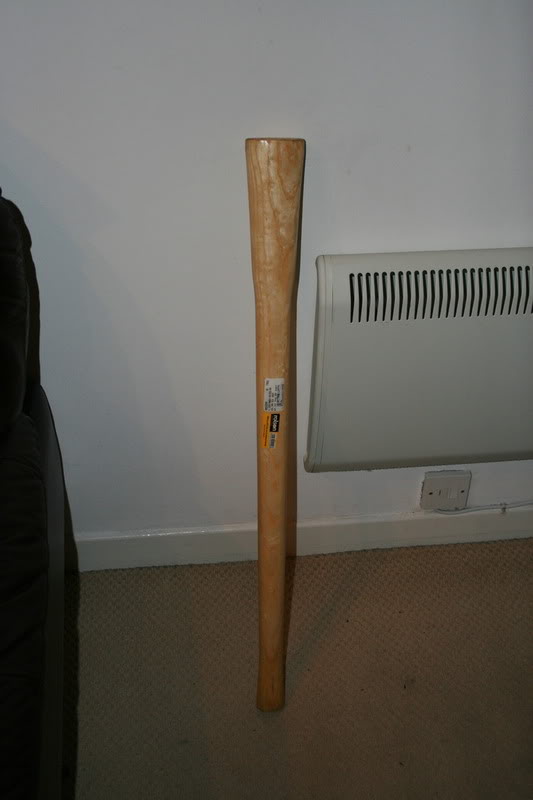
A heartbreaking story took place today, unfortunately. I took it in for a stress test at my Medieval Martial Arts Society, to be hit with blunted swords, simulating the battle conditions it will be in the worst case scenario. A friend took a mighty swing at it, and the sword snapped, but only after leaving a huge gash. Juliet was an old sword and, in her memory, my axe will be named Romeo.
Here is what the haft looks like after some bouts and the full-strength stress test:
This is the deepest cut (from Juliet), as well as some smaller dents from a less brutal bout.
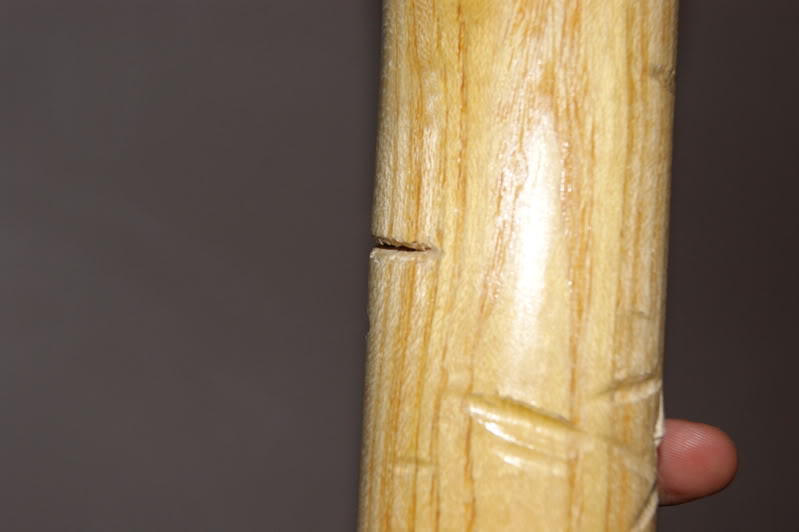
More nicks and scratches
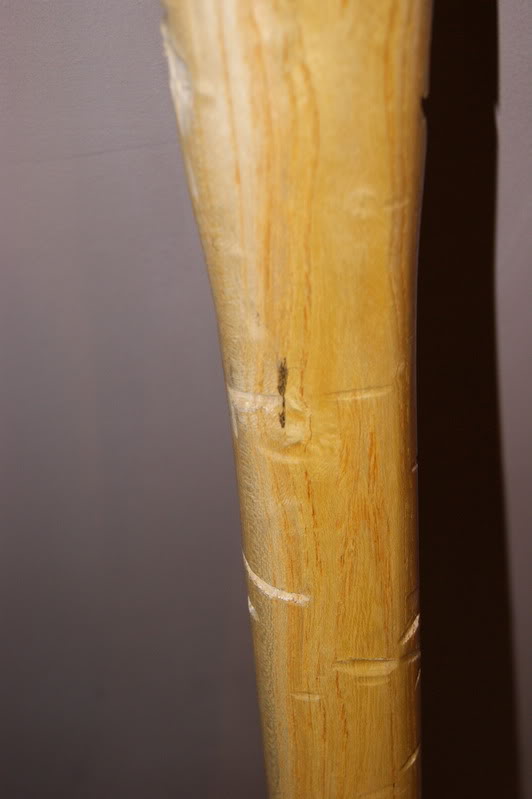
One of the few times it actually got chipped
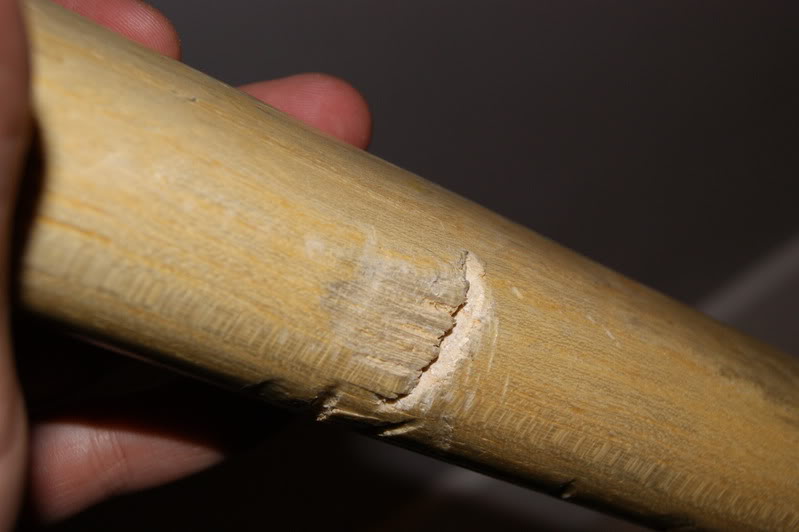
The next step is acquiring a plane and shaving off the huge amount of excess wood:
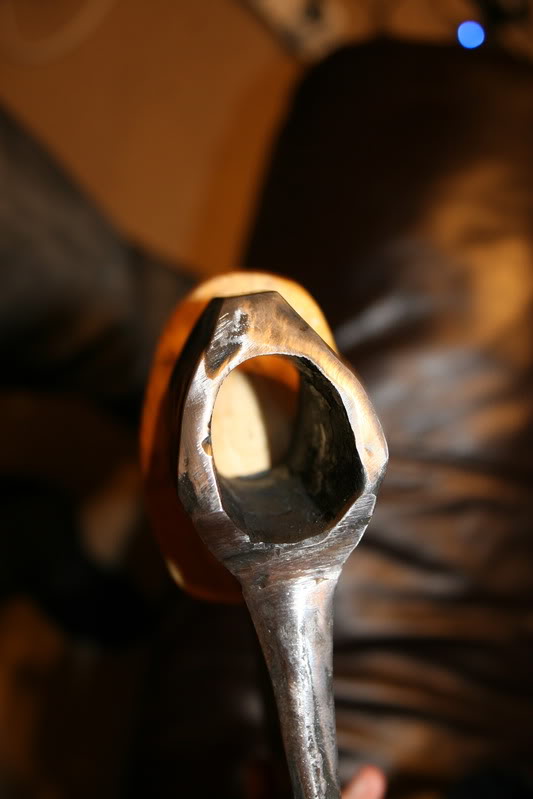
I should be updating as soon as I get to work with the plane 
|
|
  |
 |
|
Peter O Zwart
Location: Ontario Canada Joined: 28 Nov 2010
Posts: 69
|
 Posted: Sat 19 Mar, 2011 6:21 pm Post subject: Posted: Sat 19 Mar, 2011 6:21 pm Post subject: |
 |
|
Looks like fun! lots to do with the plane. Just remember that if you dry the wood out before you haft it you should not remove all the material as the wood will shrink, unless you are planning on using a wedge.
Looking forward to seeing more of this ax.
|
|
  |
 |
|
Julian Reynolds
Location: United Kingdom Joined: 30 Mar 2008
Posts: 271
|
 Posted: Sun 20 Mar, 2011 1:10 am Post subject: Posted: Sun 20 Mar, 2011 1:10 am Post subject: |
 |
|
Mihai,
Your new haft doesn't look like oak or beech, but more like ash.
I have used ash cricket stumps in the past to haft axes - regulation match stumps are made to a standard size - length 28" (+ tapered spike) x dia. 1 3/8" (ie. 35mm) and can be bought very cheaply, or even found in junk shops. They are generally made from good, straight-grained wood, although you will have to strip the varnish.
Julian
 Attachment: 17.08 KB Attachment: 17.08 KB
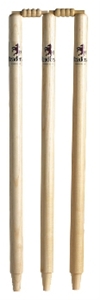
|
|
  |
 |
Mihai Georgescu

|
 Posted: Mon 21 Mar, 2011 5:17 am Post subject: Posted: Mon 21 Mar, 2011 5:17 am Post subject: |
 |
|
| Julian Reynolds wrote: | Mihai,
Your new haft doesn't look like oak or beech, but more like ash.
Julian |
That's even better! At this stage, though, I probablpy won't be hunting down anything else. As long as it's a European hardwood (which it pretty much proved in the stress test), it's fine by me 
Hopefully getting a plane sometime this week.
Thanks for the recommendation for the cricket supplies! I'm using my society's cricket gloves as hand protection to tide me over until I get my own hand protection, and they work great!
|
|
  |
 |
Mihai Georgescu

|
 Posted: Fri 25 Mar, 2011 7:59 am Post subject: Posted: Fri 25 Mar, 2011 7:59 am Post subject: |
 |
|
I've finally acquired a plane and got cracking on planing the haft. I am aiming to have it finished by Sunday, but at the rate I am going at, that seems unlikely.
Here's the haft after two nights' worth of work.
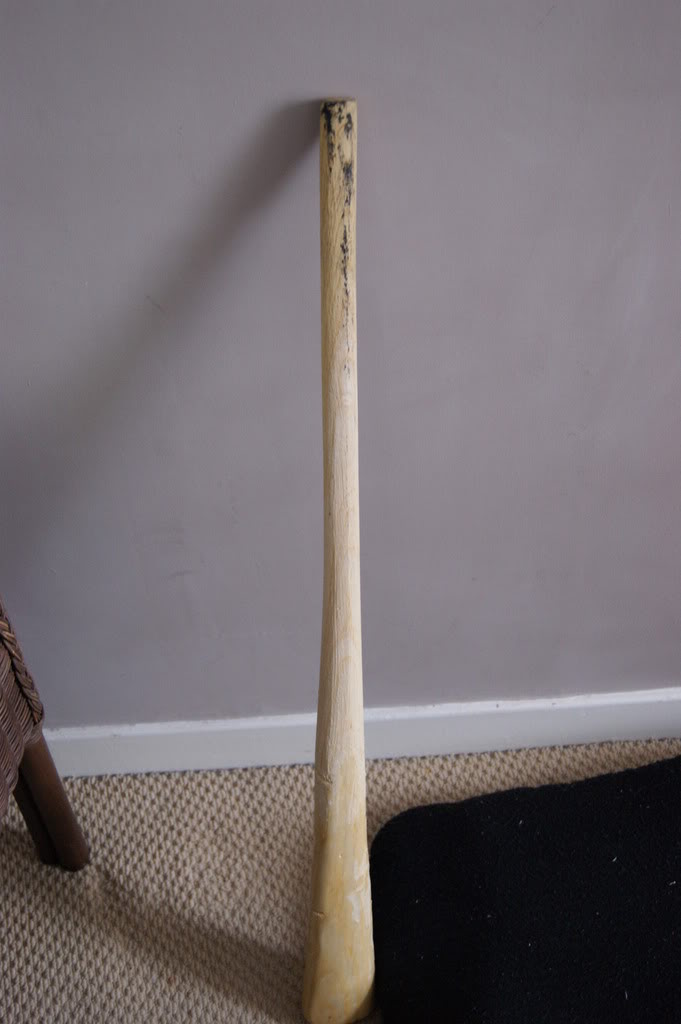
And with the head on (I constantly try it on, to see my progress and to make sure I don't make it too thin)
http://i2.photobucket.com/albums/y39/skidesigns/DSC00487.jpg
The blackened bits are from the dabs of paint I put on the inside of the head to see which parts I need to shave off most.
I hope I can get it ready for Sunday, looks like I've got my work cut out for me 
|
|
  |
 |
Mihai Georgescu

|
 Posted: Fri 01 Apr, 2011 11:32 am Post subject: The finished project - Not so much a Dane axe, at all! Posted: Fri 01 Apr, 2011 11:32 am Post subject: The finished project - Not so much a Dane axe, at all! |
 |
|
I haven't posted in a while, I've had a tremendously busy couple of weeks again.
From the last update here was the haft as I planned to use it on the axe:
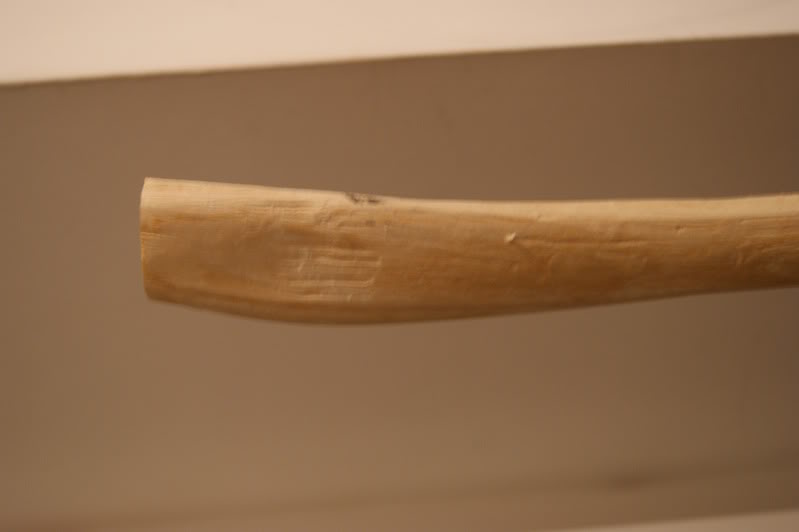
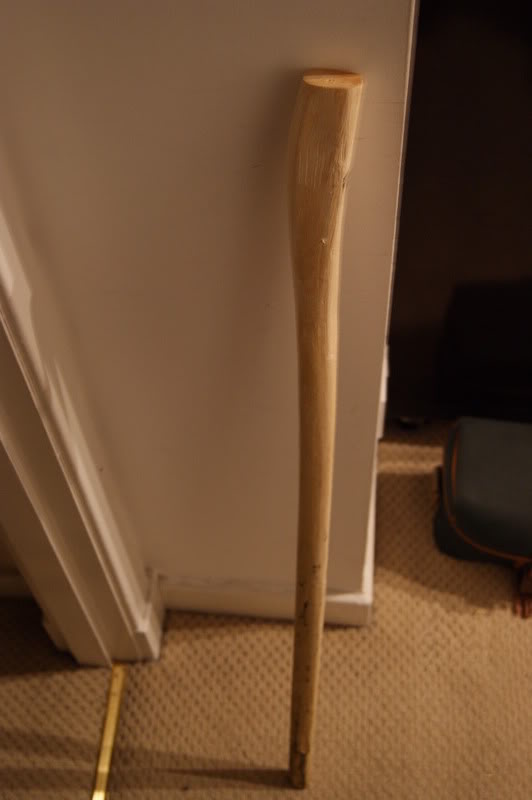
The head was meant to go face-forward onto the bit that bent forward (So the target was reached faster).
However, here is what happened when I actually started putting the head of the axe on:
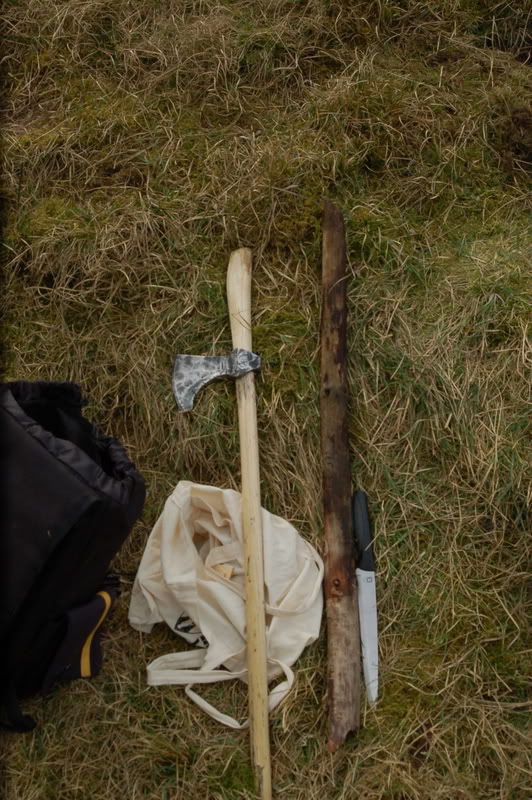
It was stuck. Either way. The hammer I was using to force it upwards broke (it's what I get for using Poundland tools), so I resorted to using a particularly heavy stick, which also broke twice. I felt that the name Allbrotnar (Allbreaker) was very suitable 
Unable to make much more progress, I gave up and cut off the extra bit of the haft (about 10 cm). This makes the finished axe approximately 890 cm long or 35 in. Although this is technically the short -end of the spectrum for Dane axes, I would hesitate to call it that. Here it is finished, compared to my arm:
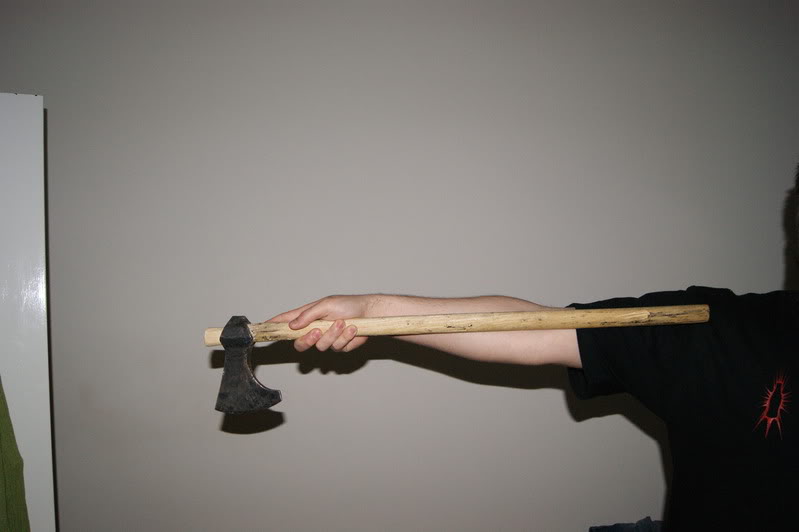
While some of the folks in my group can use it as a single-hander, I am little shorter (and weaker :P) and use it as a two-hander (though I can make single-handed cuts occasionally). Fortunately, the axe feels great, it is well balanced and has been praised by some of the more experienced members in my group (which was somewhat flattering).
A few more images of the finished product:
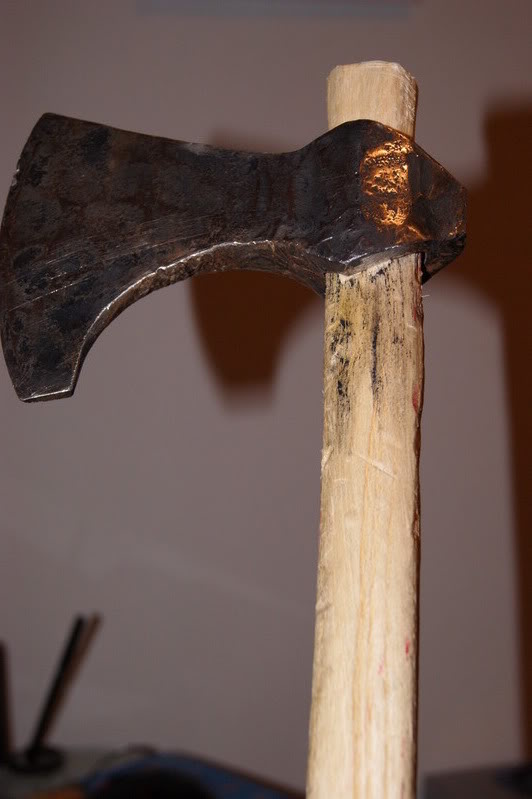
Thin wedges at the top and bottom, to secure it completely:
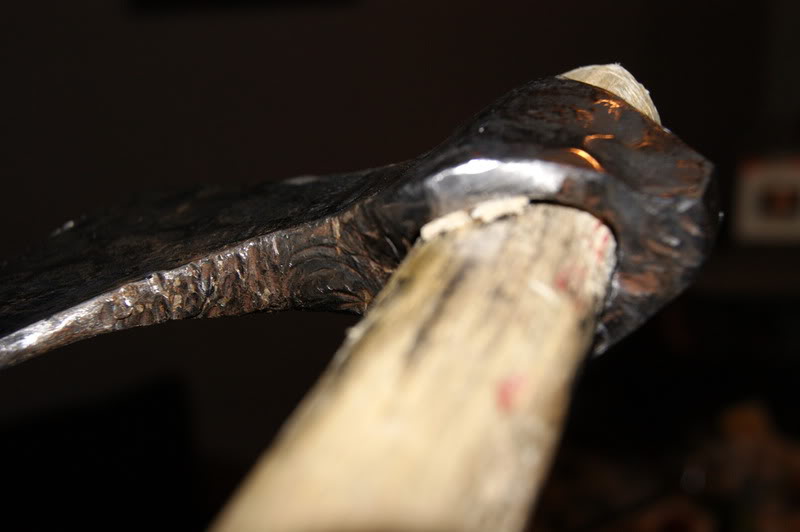
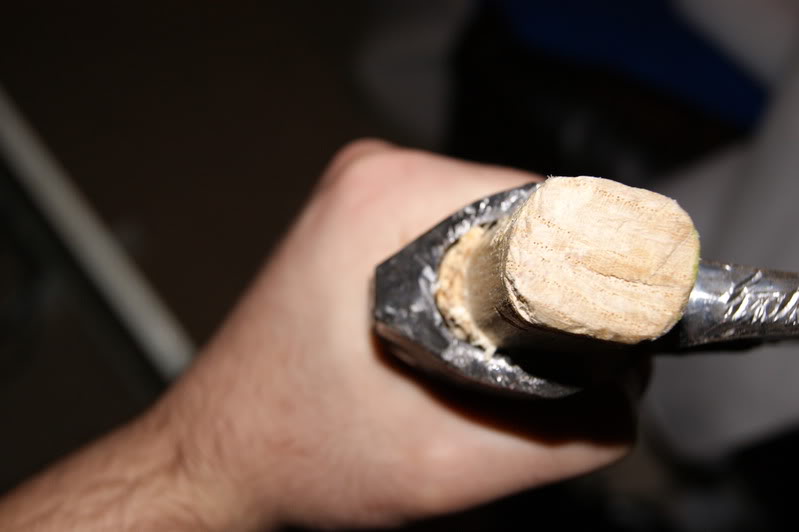
The axe alongside the leftover haft, which I might use for a dagger handle.

Thanks to everyone who helped with advice! Now if I could only edit the title of the thread.
|
|
  |
 |
|
Julian Reynolds
Location: United Kingdom Joined: 30 Mar 2008
Posts: 271
|
 Posted: Fri 01 Apr, 2011 4:19 pm Post subject: Posted: Fri 01 Apr, 2011 4:19 pm Post subject: |
 |
|
Can I suggest (a little too late for this project) that one tool I find invaluable for shaping hafts is the Japanese Saw Rasp (see pic below). These have a coarse and a fine side to them , and don't clog up as the shavings fall through the lattice. They are really cheap (approx £15) for a tool that will last a very long time and is so useful, particularly for shaping curved or circular forms like hafts or if you are also, like me, into stickmaking and woodcarving. You'll need to finish with sandpaper or scraper, of course.
Julian
 Attachment: 2.54 KB Attachment: 2.54 KB
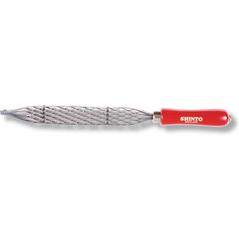
|
|
  |
 |
Mihai Georgescu

|
 Posted: Sun 03 Apr, 2011 4:50 pm Post subject: Posted: Sun 03 Apr, 2011 4:50 pm Post subject: |
 |
|
Thanks, Julian, will keep that in mind the next time I haft a weapon 
|
|
  |
 |
|
|
You cannot post new topics in this forum
You cannot reply to topics in this forum
You cannot edit your posts in this forum
You cannot delete your posts in this forum
You cannot vote in polls in this forum
You cannot attach files in this forum
You can download files in this forum
|
All contents © Copyright 2003-2025 myArmoury.com — All rights reserved
Discussion forums powered by phpBB © The phpBB Group
Switch to the Basic Low-bandwidth Version of the forum
|

